Nature of Early Play designs creative play equipment that connects children with the natural world.
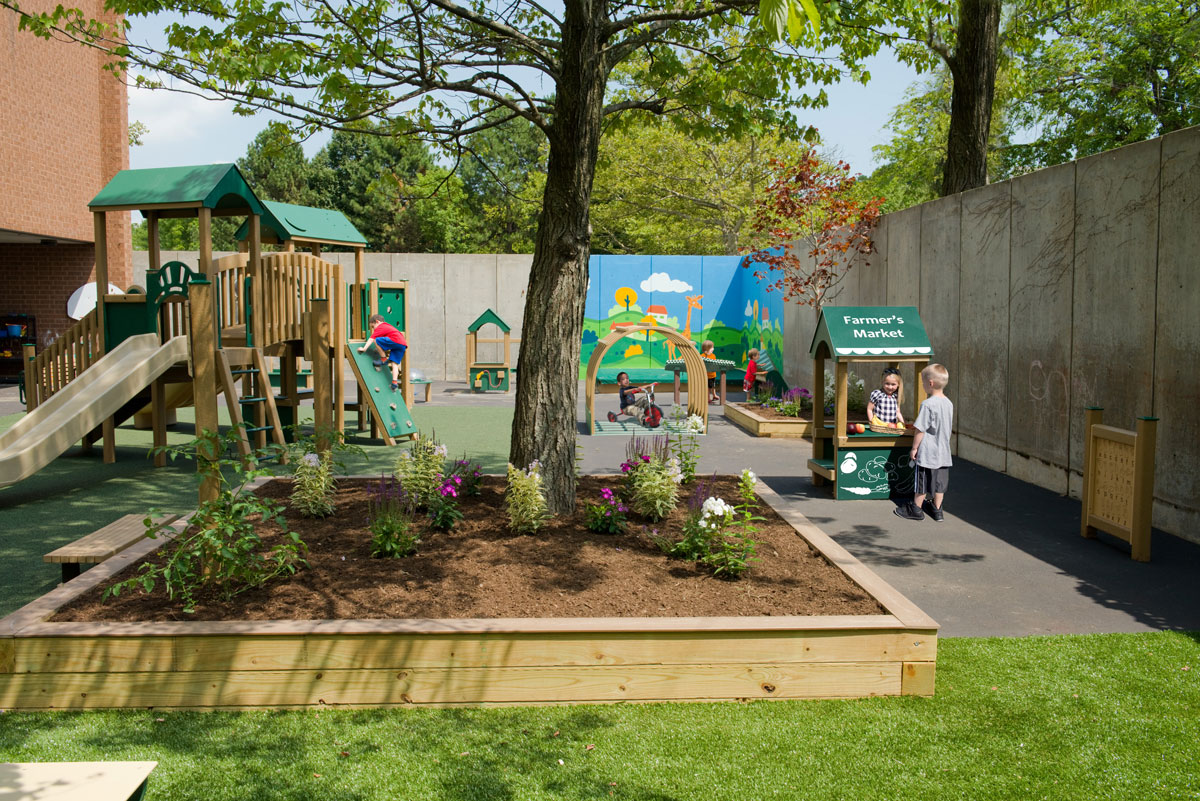
Innovations like the farmers’ market stand make playtime interactive and educational. [Photo: Courtesy of Nature of Early Play]
Dennis and Rebecca Beach, owners of playground equipment company Nature of Early Play, have been warm-hearted environmentalists from the start. The couple raised and homeschooled their five kids in the heart of nature on 23 acres of land in Kentucky. The entire family used to work together at their mom-and-pop shop in the family barn. Dennis drew his designs by hand and the kids helped cut and paste the drawings. The children grew up outdoors, running down to the creek, gardening, and raising animals.
“We got to experience the real ‘getting back to nature’ concept that’s at the heart of our products today,” says Tabitha Beach Sani, director of marketing at Nature of Early Play. “When my parents developed the early childhood product line for Nature of Early Play, it really was just bringing it full circle.” She says her parents were truly hippies who wanted to save the world, always wanting to foster “messy little scientists.”
FROM OUR JULY+AUGUST 2018 ISSUE
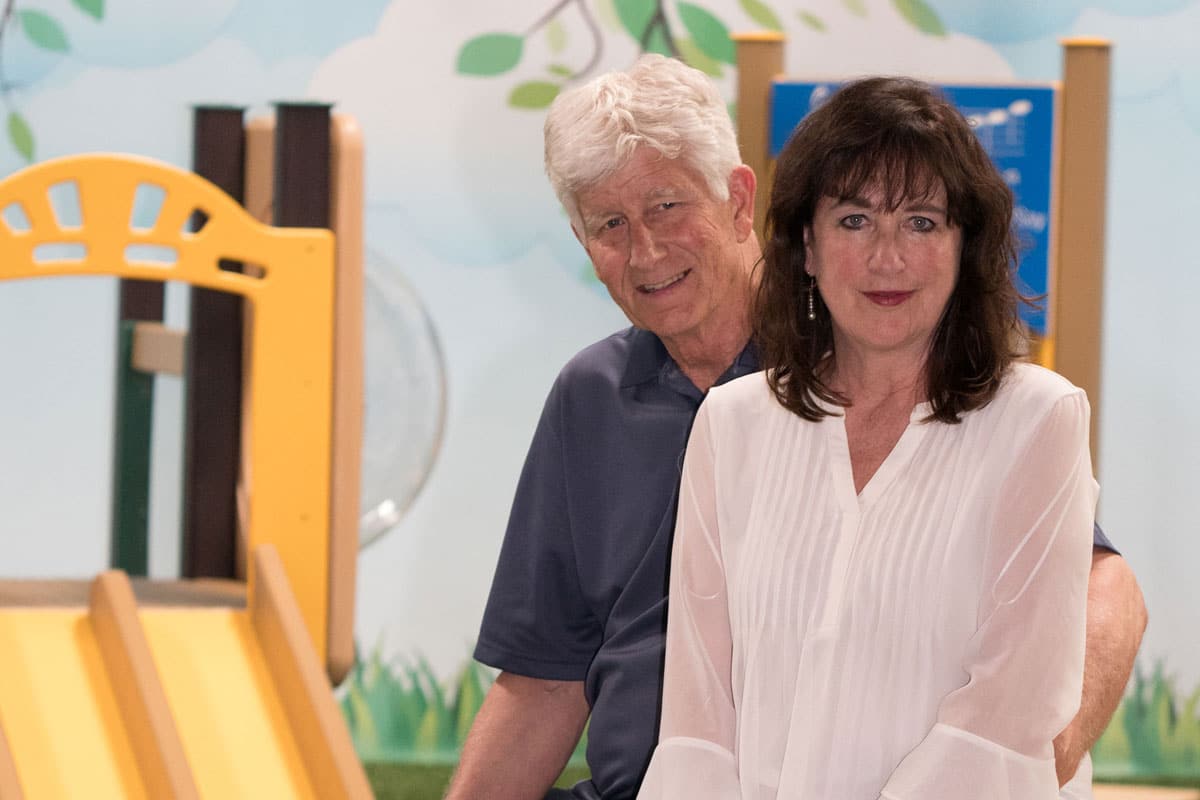
[Photo: Courtesy of Nature of Early Play]
“We want to build infrastructure that helps caregivers easily take care of young children while letting them experience nature,” Dennis says. When it comes down to it, Nature of Early Play embodies the same green passion as its owners, giving young children who aren’t surrounded by nature the chance to learn about the natural world through innovative playtime products.
Branching Out
Every family member has made a positive impact on the business: one daughter helped them develop their software system, one son helped build their sales representative network, and another daughter helped them get certified by the International Play Equipment Manufacturers Association. “However, after being homeschooled and working in the family business for years, a lot of the kids wanted to spread their wings,” Rebecca says.
While she now lives several states away, Dennis and Rebecca’s daughter Tabitha still designs graphics and creates the company’s catalogs; she also helped design their website. “Being homeschooled and then working with the company helped each one of us kids develop our own career path and skill set,” Tabitha says.
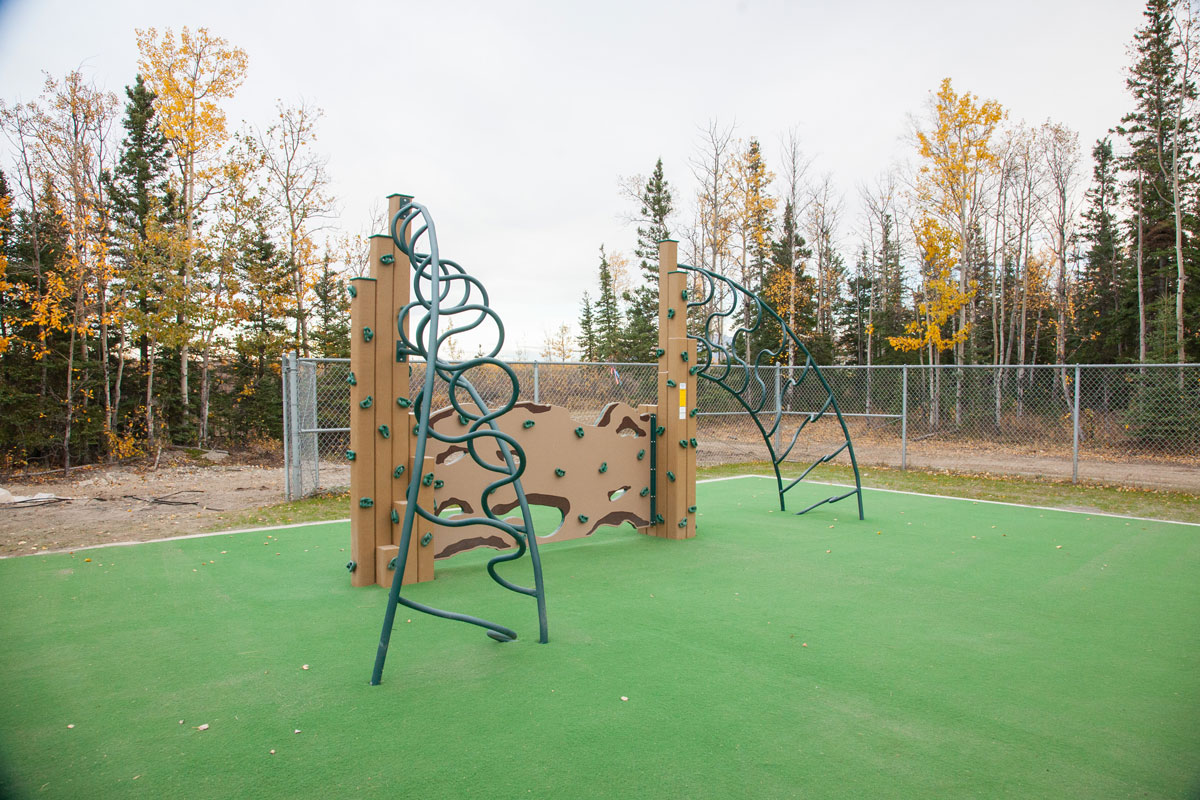
[Photo: Courtesy of Nature of Early Play]
Nature of Early Play branched out from Dennis and Rebecca’s original company, Play Mart, which designs products primarily for children from ages 5 to 12. In 2006, the Beaches went to an advanced summer design course at Harvard University. It was there that the couple realized there were very few U.S. manufacturers with age-appropriate equipment for infants and preschoolers. They began developing a product line to fill the great need for early childhood play equipment in the marketplace. These early childhood products eventually became the stand-alone company Nature of Early Play, Inc.
The Best Materials
When Rebecca and Dennis first began making playgrounds, they used wood. But wood has many problems—it cracks, splits, and rots. That’s why they switched to high-quality recycled lumber. “We had a problem with our vendor taking forever to get the lumber to us, so we said, ‘Let’s do it ourselves,’” Rebecca says. The couple bought a 120-foot long machine that extrudes plastic lumber out of milk jugs. They have since saved millions of pounds of plastic from going into landfills.
“The materials we use are recycled, and they’re definitely a part of Mom and Dad’s passion to conserve both energy and materials,” Tabitha says. “Every item that’s designed is put through Dad’s conservation brain.”
In the early days, Dennis created a materials efficient modular deck, post, and component design system. This simple system allowed even the kids to help create new playsets by copying and pasting paper components. Later he used this same modular concept to design the molds for the recycled plastic lumber profiles, which allow for ease in designing and installing play equipment. All of the components fit together down to one-sixteenth of an inch. This modular design makes it easy to rearrange all of their products, allowing for great flexibility and efficiency, too.
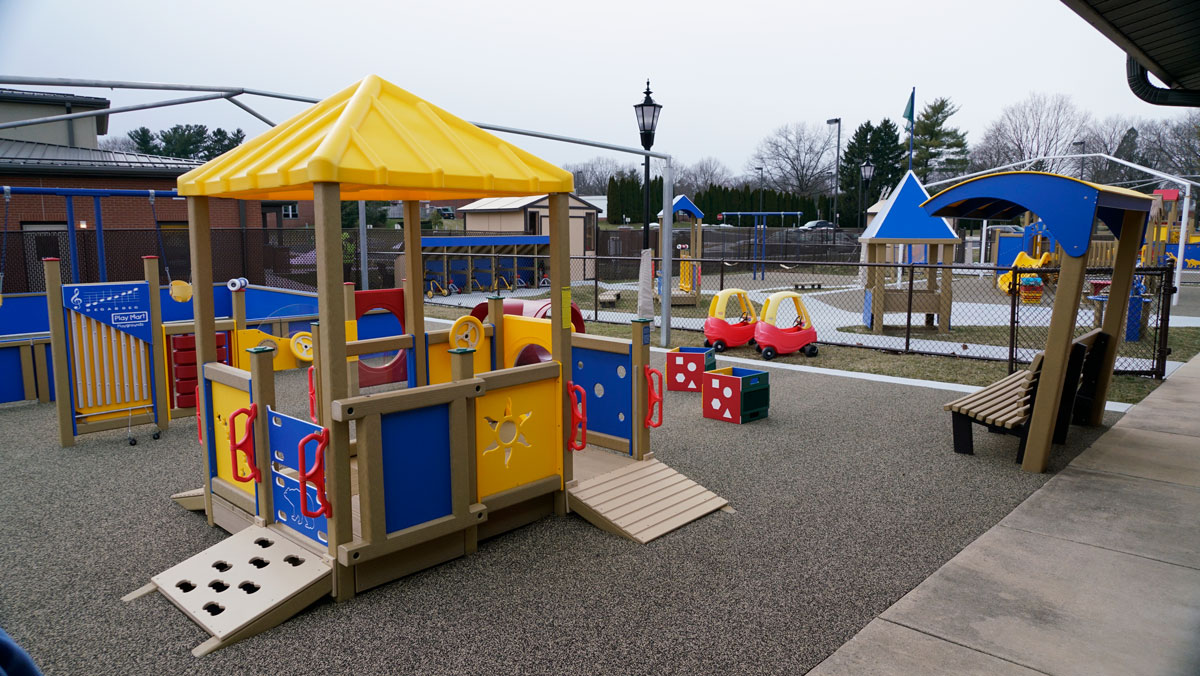
[Photo: Courtesy of Nature of Early Play]
The Design Process
Much of their design inspiration comes from observing how kids play and from raising their own family in the heart of nature. Dennis and Rebecca recently visited their new grandchild in California and took him to an infant park. “Most places don’t really have any early childhood public parks, so it was fun to watch this whole herd of really little ones play with sand and lots of little plastic toys,” Dennis says. “That’s where creative ideas come from—when you see the things the kids don’t play with and, vice versa, the things they’re really attracted to.”
One interesting thing they noticed was that barely any of the children played on the wooden playset. Most of the children were using individual push toys, tables with sand, or digging in the dirt. “It used to be that people just wanted one really big playset, but kids don’t want to just hang out on a big playset,” Rebecca says. That’s why Nature of Early Play focuses on providing different, more age-appropriate play experiences.
Creative & Versatile Equipment
One Scandinavian saying inspired Dennis and Rebecca’s outdoor equipment designs: “There’s no such thing as bad weather, only bad clothes.” Whether it’s warm or cold outside, Nature of Early Play aims to bring real natural materials—like mud and snow—back to playtime.
“Our philosophy is that we’re not going to build concrete trees or something that looks like it’s a natural product,” Rebecca says. The Nesting Table is a perfect example. It’s a simple table that varies by height with age. Waterproof and on wheels, it’s easy to move inside and outside as needed. “It’s what we like to call ‘the infrastructure’ because it’s up to the caretaker to bring in natural materials,” Rebecca says. One day the kids could make mud pies, and then during the winter they could build snow structures.

[Photo: Courtesy of Nature of Early Play]
The tables also work for storing small toys like Legos. The reversible lid can be used as a scoop to dump the blocks into the bin, and it closes for easy cleanup. “Our products make life easier for caregivers to give much more hands-on, active play without wasting all the time cleaning up everything,” Dennis says. Some products even include cleanup stations, so when the kids are done playing in the mud, they can wash their hands.
Nature of Early Play also encourages gardening with a little farmers’ market, raised garden beds, and tables where kids can sort vegetables. On top of that, they offer arts and crafts areas, musical instruments, and tricycle paths. Eric Evans, owner of Total Recreation Solutions in Virginia, has installed Nature of Early Play’s products all over the U.S., bringing gardening and water play into countless playgrounds. “We do a lot of tricycle paths with trike garages and tunnels at preschools and daycares,” he says. “This equipment gets the kids out of the classrooms and away from iPads and tablets and video games and into the dirt, sand, and water. I really believe in this product and the initiative behind it—the quality and the green aspect.”
Sustainable Manufacturing
Nature of Early Play’s manufacturing process is green, too. They recycle all scraps by grinding them up and putting the plastic back into the plastic extrusion system. A county recycling company comes in weekly to collect all of their single-stream recyclables. “We use many tractor trailer loads a year of post-consumer milk jugs from city recycling companies and dairies,” Dennis says.
The manufacturing plant itself has 64 skylights that produce abundant natural daylight, meaning overhead lights are less needed. “All the high bay lighting we had before was really energy inefficient, so we’ve done lots of LED lighting down low over work areas,” Dennis says.
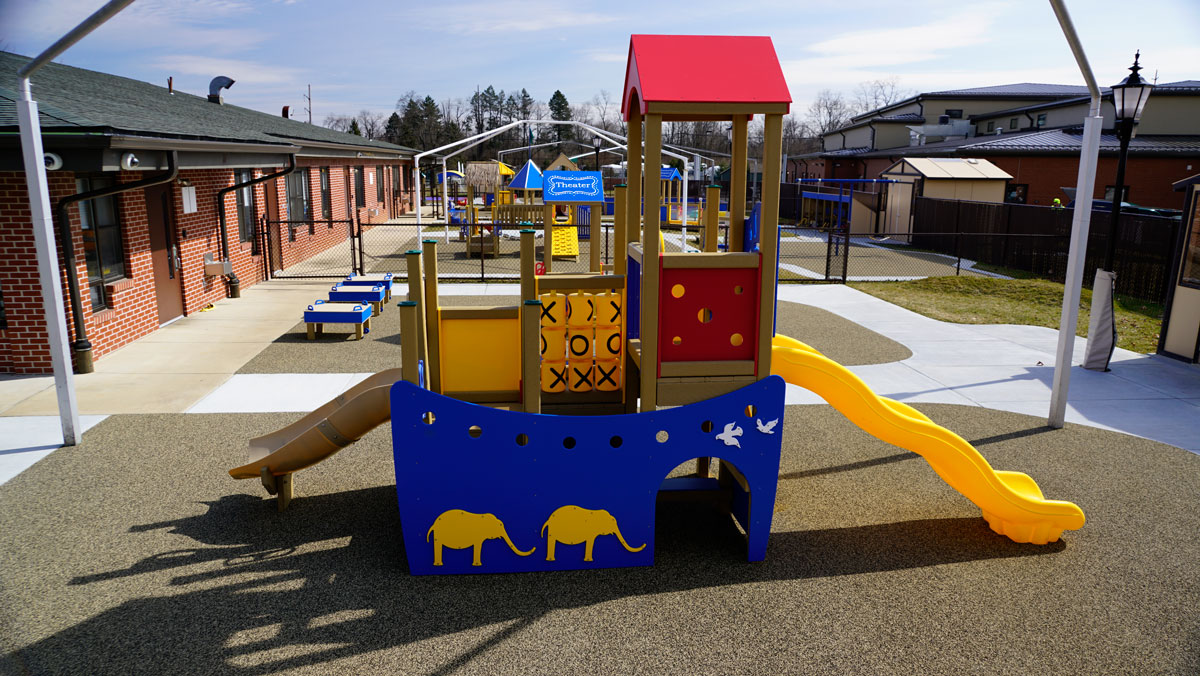
[Photo: Courtesy of Nature of Early Play]
The plastic extrusion system used to be cooled by a chiller, which used a lot of electricity for fans and compressors. But now Dennis and his team cool the plastic extrusion machines with a 10,000-gallon water tank hooked to several pumps with recirculating groundwater. This greatly reduces their carbon footprint.
Wasting gas and mileage isn’t an issue either. The dairies they source the plastic from are close to the plant, which is in a central location—Somerset, Kentucky. A local trucking company hauls their products to nearby projects, usually within a day’s drive.
The Future
As Nature of Early Play continues to grow internationally, they also look to expand by finding new distributors in Europe, Asia, and South America. Currently Nature of Early Play is expanding its line of infant playground equipment, as not many manufacturers are designing products that meet ASTM F2373 standards for the six months to 23 months age group. They recently manufactured tiny slides for infants that fit within their modular systems. They designed another unique product called the Infant Mod Space—an outdoor pad with protective low walls where an infant can safely crawl, learn to stand, or simply lie outside. It allows babies to play outdoors and have natural sensory experiences. They also developed a belly swing. It’s just a few inches above a cushioned pad with a pivot point of about two-and-a-half feet. Infants can lay in the belly swing and gently push their legs back and forth just a few inches for a safe, pleasant time. “We had a swing inside our house, and one of our daughters used to just lay there on her belly and swing back and forth,” Dennis says. “When we saw it in this standard, we thought, ‘How cool. We have to design that.’” They took the belly swing to a trade show and the woman who wrote the ASTM standard came up to them crying, Dennis says. She said they were the first ones who had ever built such a thing—and she couldn’t be happier.
Designing for the Military
An agency contacted Nature of Early Play through a prime contractor for the U.S. Army and asked them to help with their initiative to revamp the military’s child development centers. Dennis and Rebecca Beach traveled to the sites in their new electric car, saving about 70% of their total carbon emissions. “There was a visionary from the army, and she had a heart that was very similar to Rebecca’s for giving children imaginative and creative places to play,” Dennis says. When they rebuilt a network of 14 play areas at a base in South Carolina, they designed every playground for each age group with interactive, age-appropriate play equipment. “Some of the children have both parents deployed in the army, so the kids would actually live at the daycare centers off and on around the clock,” Dennis says. That’s why this project was so important—not only were the child
development centers a place to play;
they also acted as second homes.


